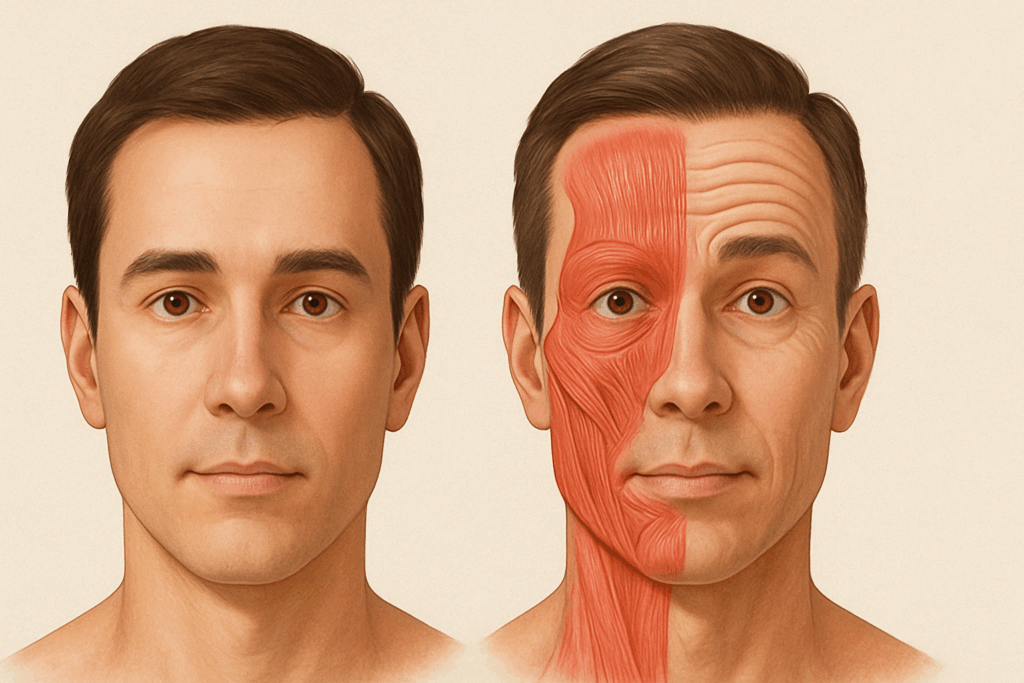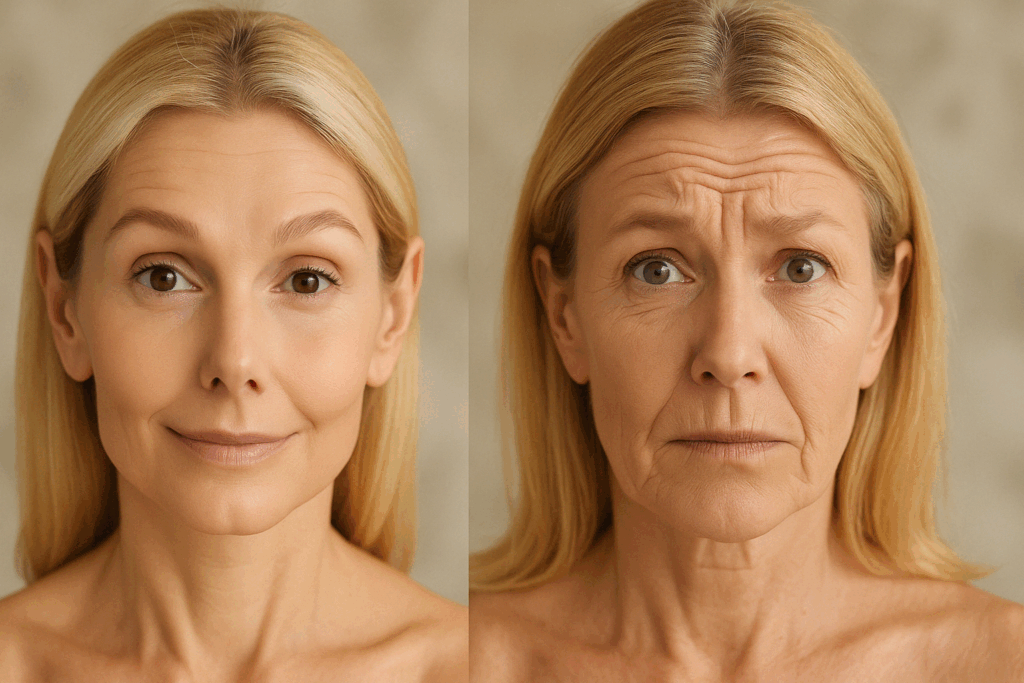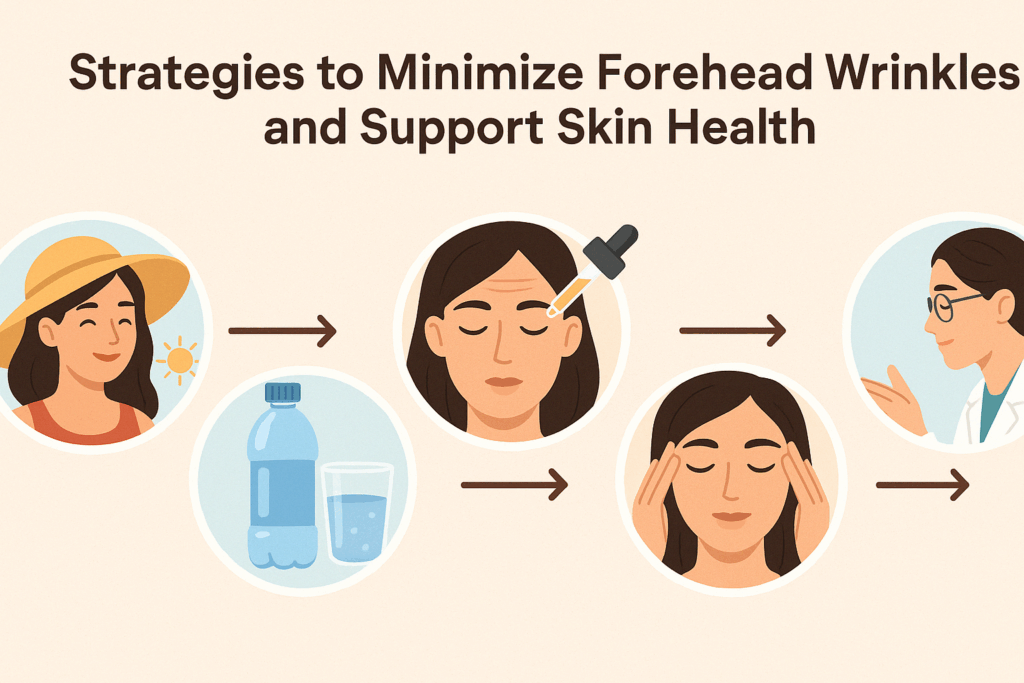Understanding why forehead wrinkles appear when you raise your eyebrows is more than just a cosmetic curiosity. It touches on the intersection of skin physiology, muscular anatomy, genetic predisposition, and even emotional expression. These horizontal lines on the forehead are often among the first visible signs of aging, and their appearance can provoke questions about skincare, lifestyle, and hereditary factors. For many, the concern extends beyond vanity; it’s a matter of understanding what your body is telling you and whether certain changes are preventable or simply part of your unique genetic blueprint.
You may also like: How to Choose Skin Care for Fine Lines: Evidence-Based Tips for Healthier, Younger-Looking Skin
The movement of the eyebrows, particularly when lifting them in surprise or emphasis, repeatedly contracts the frontalis muscle, a broad sheet of muscle that spans the forehead. This repeated movement creates dynamic wrinkles, which over time become more permanent as skin elasticity diminishes. However, while muscle movement plays a central role, it does not act alone. The composition of your skin, the structural collagen beneath it, and your body’s ability to repair micro-damage are heavily influenced by your genetic makeup. Thus, a seemingly simple expression like raising your eyebrows can initiate a cascade of physiological effects that culminate in visible forehead wrinkles.
Delving into this topic requires examining the interplay between muscle activity, aging mechanisms, environmental influences, and inherited traits. It also calls for a broader understanding of how lifestyle choices can either accelerate or mitigate the progression of these lines. From a dermatological standpoint, the distinction between intrinsic and extrinsic aging is fundamental—where intrinsic aging is genetically programmed and inevitable, extrinsic aging is influenced by environmental exposures such as sun, pollution, and personal habits.
In the following sections, we explore why forehead wrinkles when raising eyebrows are so common, what science reveals about horizontal lines on the forehead, whether expressions alone cause permanent creasing, and how genetics sculpt the skin’s aging narrative. We also look at what practical steps can be taken to reduce or slow their development, offering both a scientific lens and a wellness-oriented perspective.

The Muscle Behind the Movement: Why Raising Eyebrows Wrinkles the Forehead
The physiology behind facial expressions, particularly the act of raising the eyebrows, is rooted in a specific muscle: the frontalis. This muscle stretches from the top of the skull down to the eyebrows and is responsible for lifting the brows and causing the forehead skin to move vertically. When the frontalis contracts, it pulls the skin upwards, which creates temporary folds or horizontal lines on the forehead. Over time, these folds deepen into more permanent wrinkles, especially with repeated use.
The skin on the forehead is relatively thin compared to other parts of the body, making it more susceptible to the effects of repetitive motion. In youth, the skin snaps back easily due to abundant collagen and elastin, but as the skin ages, it loses its ability to rebound. This natural reduction in skin elasticity means that expressions which once left fleeting creases now leave lingering lines. The frequent use of the frontalis muscle is one of the primary reasons why people first notice forehead wrinkles when raising eyebrows.
Yet not all individuals develop the same degree or depth of forehead lines, even if they make similar facial expressions. This discrepancy points to factors beyond muscle movement, including hydration, sun exposure, skincare routines, and most notably, genetics. Still, the mechanical action of raising the eyebrows remains a central contributor to dynamic forehead lines, especially when paired with other compounding variables.
For those who habitually raise their eyebrows—whether from habitual expression or as part of their communication style—the impact is often magnified. Over time, those dynamic wrinkles become etched into the skin as static lines, visible even when the face is at rest. While facial expressions are a natural and healthy part of human interaction, understanding their physical effects allows for a more informed approach to long-term skin care and wrinkle prevention.

Horizontal Lines on the Forehead: Aging Markers or Expression Scars?
The horizontal lines on the forehead are among the most recognizable signs of aging, yet they also serve as subtle markers of emotional and behavioral patterns. People who frequently use their eyebrows to convey surprise, curiosity, or concern often develop deeper forehead lines earlier in life. While these creases are commonly associated with aging, they are just as often the result of expressive habits developed over decades.
From a clinical perspective, dermatologists distinguish between dynamic and static wrinkles. Dynamic wrinkles appear during muscle movement, such as when raising the eyebrows. Static wrinkles, by contrast, are those that remain visible even when the face is at rest. Horizontal lines on the forehead often begin as dynamic but eventually become static with age and repeated motion. This transformation is accelerated by the gradual decline in skin collagen, a fibrous protein that provides structural support to the dermis.
Environmental exposure plays a critical role in deepening these lines. Ultraviolet radiation from the sun, in particular, breaks down collagen and elastin fibers in the skin, accelerating the formation of permanent creases. Other factors such as pollution, cigarette smoke, and even chronic stress contribute to oxidative stress, further weakening the skin’s resilience. In this context, the horizontal lines on the forehead become more than just a consequence of expression—they are cumulative imprints of environmental and emotional stressors acting on genetically predisposed skin.
It is also worth noting the psychological impact of these lines. In a culture that places a premium on youth and smooth skin, forehead wrinkles are often perceived as undesirable. Yet they are also signs of a life lived expressively. This dual perception reflects a tension between aesthetic ideals and the authenticity of visible aging. Whether seen as flaws or features, these lines tell a story that extends beyond the superficial, rooted in how we move through the world and how our biology processes those movements.

Does Raising Your Eyebrows Cause Wrinkles, or Is There More to the Story?
A question that surfaces frequently in dermatology consultations is: does raising your eyebrows cause wrinkles? The short answer is yes—but the full picture is more nuanced. The act of raising your eyebrows repeatedly engages the frontalis muscle, which, as mentioned, leads to dynamic wrinkles. Over time, if the underlying skin is not resilient enough to recover from this folding, those wrinkles become static. However, this is just one piece of a multifaceted puzzle.
Wrinkle formation is not solely dictated by expression. The integrity of the skin barrier, the rate of cellular turnover, hormonal changes, and lifestyle choices all influence how and when wrinkles develop. Someone with naturally thicker skin and higher collagen density may raise their eyebrows frequently yet show minimal wrinkling. Conversely, an individual with thinner skin or reduced skin hydration may develop wrinkles even with moderate facial movement.
Research also underscores the role of chronic inflammation in accelerating wrinkle formation. Conditions like photoaging, where the skin is chronically exposed to UV light, create low-level inflammation that damages dermal collagen and elastin. In such cases, even mild facial movements can produce pronounced wrinkles because the skin lacks the structural integrity to withstand repeated folding. Thus, while raising your eyebrows can cause wrinkles, the process is significantly modulated by skin condition, environmental exposure, and internal health factors.
Another layer to consider is behavioral patterning. Some people habitually raise their eyebrows in response to nearly every stimulus, whether in conversation, during concentration, or as a reaction to light. This repetitive movement, ingrained over years, has a more pronounced impact on wrinkle formation than the occasional expression of surprise. Therefore, the frequency, duration, and intensity of the movement all play roles in determining its impact on the skin.
This understanding shifts the question from a simplistic cause-and-effect framework to a broader, more informed discussion of wrinkle etiology. It encourages both preventive strategies and a deeper appreciation for how subtle differences in behavior, biology, and environment can lead to significant aesthetic outcomes.

Are Forehead Wrinkles Genetic? Decoding the Role of Heredity in Skin Aging
The question “are forehead wrinkles genetic?” leads us into the fascinating field of epigenetics and dermatogenomics—the study of how genetic variations influence skin characteristics and aging. The short answer is yes, genetics play a substantial role in determining the onset, severity, and distribution of forehead wrinkles. But how these genetic predispositions interact with lifestyle and environment is what ultimately shapes individual outcomes.
Several genes are involved in collagen production, skin elasticity, hydration, and repair. Variations in these genes can determine how robust your skin structure is, how quickly it regenerates after damage, and how resilient it is to environmental stressors. For instance, certain variants of the MMP1 gene, which codes for matrix metalloproteinases responsible for collagen breakdown, are associated with more pronounced wrinkling. Other genes like COL1A1 and ELN, which regulate collagen and elastin production, also influence how skin ages over time.
Studies involving twins have further clarified the role of heredity. Identical twins raised in similar environments often show similar patterns of wrinkle development, while fraternal twins or siblings can show greater variance, pointing to a strong genetic component. However, these studies also demonstrate that lifestyle factors such as smoking, sun exposure, and stress levels can modulate the genetic baseline. This concept is central to epigenetics—genes may load the gun, but the environment pulls the trigger.
Another intriguing genetic element is skin phototype. Individuals with fair skin (Fitzpatrick types I and II) are more prone to UV-induced damage, which accelerates wrinkle formation. Conversely, people with darker skin tones generally have more melanin, which provides a protective barrier against sun damage and delays visible aging. These inherited skin characteristics further influence how and when horizontal lines on the forehead become apparent.
Understanding the genetic basis of skin aging doesn’t imply resignation to fate. Rather, it empowers individuals to take proactive steps tailored to their genetic risk profile. Advanced skincare products, targeted dermatological treatments, and preventive lifestyle strategies can all be more effectively implemented when one understands their genetic predisposition.

Strategies to Minimize Forehead Wrinkles and Support Skin Health
While you may not be able to change your genes or completely avoid using your facial muscles, there are numerous strategies that can help reduce the appearance of forehead wrinkles when raising eyebrows. Prevention begins with protecting the skin’s structural proteins and preserving its hydration, resilience, and ability to repair itself.
Sun protection remains the cornerstone of any anti-aging regimen. Daily use of broad-spectrum sunscreen helps guard against UV radiation that accelerates collagen breakdown. Even on cloudy days or during brief sun exposure, UV rays can penetrate the skin and contribute to photoaging. Adding antioxidants such as vitamin C or E to your skincare routine can further shield the skin from oxidative stress.
Hydration is another critical factor. Well-hydrated skin is more elastic and less prone to wrinkling. Topical moisturizers containing hyaluronic acid, ceramides, and peptides can support the skin barrier and enhance its plumpness. Retinoids, derived from vitamin A, are also widely recognized for their ability to stimulate collagen production and reduce the appearance of fine lines, including those on the forehead.
Beyond topical treatments, lifestyle choices make a significant impact. Avoiding smoking, managing chronic stress, eating a diet rich in anti-inflammatory foods, and getting adequate sleep all contribute to healthier, more resilient skin. Practices such as facial massage, myofascial release, or even mindful expression awareness can also reduce tension in the frontalis muscle and limit habitual eyebrow lifting.
For those seeking more intensive interventions, medical-grade treatments such as botulinum toxin (Botox) can temporarily paralyze the frontalis muscle, preventing the motion that causes dynamic wrinkles. Dermal fillers, laser resurfacing, and microneedling are additional tools that dermatologists use to smooth horizontal lines on the forehead and stimulate collagen remodeling.
Ultimately, the goal isn’t to erase all signs of aging but to support skin health in a way that aligns with your personal values and aesthetic goals. An informed, proactive approach grounded in both science and self-awareness offers the best pathway to maintaining skin that feels as good as it looks.

What Your Forehead Lines Say About You: Reflecting Biology, Behavior, and Inheritance
At first glance, forehead wrinkles when raising eyebrows might seem like an inevitable part of aging, a minor cosmetic concern in the broader scheme of health and wellness. But as we have explored, these lines are layered with meaning—they reflect the underlying anatomy of facial expression, the biology of skin aging, the behavior patterns ingrained over a lifetime, and the powerful influence of genetic inheritance.
Horizontal lines on the forehead serve as a visual chronicle of our emotional expressiveness, a subtle testament to the way we interact with the world. While it is true that repeated movements such as raising your eyebrows can contribute to wrinkle formation, it is equally important to recognize the profound role of internal and external influences that shape how those lines develop. Asking whether raising your eyebrows causes wrinkles is not simply a matter of biomechanics—it opens a conversation about how lifestyle, environment, and genes converge on the skin’s surface.
The question of whether forehead wrinkles are genetic is no longer speculative. Research confirms that heredity plays a significant role, but that knowledge should not be disempowering. Rather, it invites a deeper understanding of how we can work with our biology rather than against it. Personalized skincare, sun protection, mindful movement, and holistic wellness practices all serve as powerful tools in maintaining skin vitality, even in the face of genetic predispositions.
Frequently Asked Questions: Forehead Wrinkles and Eyebrow Movement
1. Can facial yoga or expression retraining reduce forehead wrinkles when raising eyebrows?
Facial yoga has gained popularity as a natural approach to facial toning, and some enthusiasts claim it helps reduce forehead wrinkles when raising eyebrows. These exercises aim to improve muscle tone and increase blood flow to the skin, which may support collagen production. While the science is still emerging, expression retraining—which involves becoming conscious of habitual movements like eyebrow lifting—has shown promise in reducing the frequency of micro-contractions that contribute to wrinkle formation. For individuals prone to horizontal lines on the forehead, subtle changes in facial expression habits can offer gradual improvements over time. Combining facial retraining with evidence-based skincare can maximize results while minimizing unnecessary muscle strain.
2. Are there emerging technologies that target forehead wrinkles without injections or surgery?
Yes, several innovative technologies are being developed to address forehead wrinkles when raising eyebrows without the need for injectables or invasive procedures. High-intensity focused ultrasound (HIFU), fractional radiofrequency microneedling, and low-level laser therapy are gaining attention for their ability to stimulate collagen and tighten the skin non-invasively. These treatments specifically target the dermal layer to reduce horizontal lines on the forehead while preserving the integrity of facial movement. While results are not as immediate as Botox, they provide an appealing option for individuals seeking subtler and longer-term improvements. These emerging therapies may be particularly helpful for individuals whose forehead wrinkles are genetic but wish to avoid altering muscle dynamics.
3. How does long-term screen use impact forehead wrinkles from eyebrow movement?
Increased screen time often encourages facial tension, especially around the forehead and brows. People frequently raise their eyebrows subconsciously when concentrating on digital devices, leading to more pronounced forehead wrinkles when raising eyebrows over time. The combination of habitual muscle activation and blue light exposure can accelerate skin aging, making horizontal lines on the forehead more prominent. Ergonomic adjustments, blue-light blocking filters, and mindfulness of facial posture can help reduce these effects. Building awareness of how your face reacts to screen use is a key first step in managing expression-induced wrinkling.
4. Are some people more emotionally expressive due to genetics, and could that explain why some get forehead wrinkles earlier?
Interestingly, research in behavioral genetics has found that emotional expressiveness has a partially heritable component. This means some individuals may naturally use facial muscles, including the frontalis, more actively, which could explain early forehead wrinkles when raising eyebrows. When combined with skin traits that are also inherited, such as collagen density or hydration levels, this can create a “perfect storm” for early-onset horizontal lines on the forehead. People with expressive facial styles may benefit from early skincare interventions and behavioral awareness to minimize wrinkle depth without compromising natural expressiveness. In this way, the question of “are forehead wrinkles genetic” extends beyond skin structure to include emotional and neurological traits.
5. Do people with oily skin experience fewer forehead wrinkles from eyebrow movements?
Oily skin can offer a protective advantage against wrinkle formation, particularly when it comes to forehead wrinkles when raising eyebrows. The excess sebum helps maintain skin moisture and elasticity, allowing it to recover more easily from repeated muscle movement. As a result, horizontal lines on the forehead may appear later or with less intensity in individuals with naturally oily skin compared to those with dry or combination skin. However, this does not negate the influence of genetics, UV exposure, or repetitive expressions. Proper skin care that balances oil production without overdrying can help preserve these natural anti-wrinkle benefits.
6. Can early skincare routines prevent wrinkles caused by raising eyebrows?
Preventive skincare is one of the most effective strategies to slow the development of forehead wrinkles when raising eyebrows. Starting in your 20s or 30s, incorporating antioxidants, daily sun protection, and hydrating serums can build skin resilience. These measures help maintain collagen and elastin levels, making horizontal lines on the forehead less likely to deepen over time. Expression awareness also plays a role—being mindful of repeated eyebrow movements can reduce mechanical stress on the skin. While genetics may set the baseline, consistent early care can greatly influence the rate at which expression lines develop.
7. Are forehead wrinkles reversible if you stop raising your eyebrows frequently?
While static forehead wrinkles are challenging to fully reverse without medical intervention, reducing frequent eyebrow raising can help soften their appearance over time. Dynamic wrinkles—those that appear only during facial movement—may diminish significantly with behavioral changes. Forehead wrinkles when raising eyebrows can become less pronounced if skin is allowed time to rest and if supportive treatments like retinoids or collagen stimulators are introduced. However, deeply etched horizontal lines on the forehead often require more advanced dermatologic care to achieve visible changes. In this sense, prevention and early habit modification remain more effective than reversal.
8. What role does sleep position play in forehead wrinkle formation?
Although raising eyebrows is a primary cause of forehead lines, sleep position also plays a surprisingly influential role. People who sleep face down or on their sides may experience skin compression that contributes to horizontal lines on the forehead, especially when combined with daily expressions. Over time, repeated mechanical pressure can reinforce the depth of existing wrinkles, regardless of whether those forehead wrinkles are genetic or expression-driven. Using a silk pillowcase and training yourself to sleep on your back can reduce friction and promote smoother skin. This often-overlooked factor can be critical in a comprehensive wrinkle-prevention strategy.
9. How does hormonal health affect the development of forehead wrinkles?
Hormonal fluctuations, particularly involving estrogen and cortisol, have a direct effect on skin quality and wrinkle formation. Estrogen supports collagen production and hydration, so its decline during menopause can intensify forehead wrinkles when raising eyebrows. High cortisol levels, often a result of chronic stress, can degrade collagen and accelerate the appearance of horizontal lines on the forehead. People who are genetically predisposed to forehead wrinkles may see them emerge earlier or deepen faster during periods of hormonal imbalance. Managing stress, supporting hormonal health through diet and sleep, and using adaptogenic skincare can help buffer these effects.
10. Could wearable tech someday prevent wrinkles by monitoring facial expressions?
The concept of using wearable technology to track and modulate facial expressions is not science fiction—it’s already being tested. Several startups are exploring devices that monitor micro-expressions, including eyebrow movements, to provide feedback in real time. Such tech could become a useful tool for reducing forehead wrinkles when raising eyebrows by alerting users to habitual expressions that contribute to horizontal lines on the forehead. Over time, this awareness could retrain facial behavior and reduce tension in key areas. While these devices are not yet mainstream, their potential to support those with forehead wrinkles that are genetic or behavioral is promising and aligns with the growing trend of personalized skincare technology.
Ultimately, these creases on the forehead are neither flaws to be erased nor signs of failure to be corrected. They are physical manifestations of a life lived with expression, emotion, and individuality. Recognizing their biological roots allows for a more compassionate and informed perspective—one that values both health and authenticity in equal measure.
In the end, forehead wrinkles are not just about skin; they are about the story written on your face. And with knowledge, intention, and care, that story can be one of both resilience and beauty.
Was this article helpful? Don’t let it stop with you. Share it right now with someone who needs to see it—whether it’s a friend, a colleague, or your whole network. And if staying ahead on this topic matters to you, subscribe to this publication for the most up-to-date information. You’ll get the latest insights delivered straight to you—no searching, no missing out.
Further Reading:
How To Reduce And Prevent Forehead Wrinkles
What causes men’s facial wrinkles: lifestyle or genetics?
Forehead Lines: Causes & Treatments
Disclaimer
The information contained in this article is provided for general informational purposes only and is not intended to serve as medical, legal, or professional advice. While Health11News strives to present accurate, up-to-date, and reliable content, no warranty or guarantee, expressed or implied, is made regarding the completeness, accuracy, or adequacy of the information provided. Readers are strongly advised to seek the guidance of a qualified healthcare provider or other relevant professionals before acting on any information contained in this article. Health11News, its authors, editors, and contributors expressly disclaim any liability for any damages, losses, or consequences arising directly or indirectly from the use, interpretation, or reliance on any information presented herein. The views and opinions expressed in this article are those of the author(s) and do not necessarily reflect the official policies or positions of Health11News.